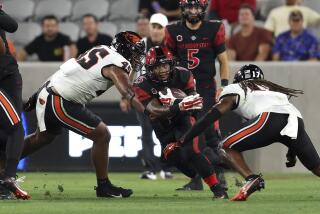The archangel of the archipelago
June Jones took over a college football show called “Hawaii 0-12.”
It was 1999, and it was horrible.
Jones inherited the nation’s longest losing streak and then, in his first game as head coach, lost a 62-7 squeaker to USC.
The program wasn’t run on a shoestring budget -- it was more an aglet (plastic tip of the shoestring).
Less than a decade later, Hawaii has gone from sugar fields to the Sugar Bowl.
No one could have seen this coming.
“To be quite honest, I did envision this,” Jones said.
OK, that makes one person.
Georgia versus Hawaii in the Sugar Bowl on Tuesday night might as well be called the Disparity Bowl, as there could not be a more divergent contrast of concepts, geography, bottom lines and cultures.
One school is from the football- and tradition-rich South, with a live bulldog mascot, Uga, who is better-dressed than most college students.
Georgia football, as a member of the conglomerate Southeastern Conference, is saturated in money. The Bulldogs play in gorgeous Sanford Stadium on crisp-sky Saturdays. Many of their fans “dress to the nines.” Before the game you can spread out checkerboard tablecloths for elaborate pregame picnics.
The annual salary of Georgia Coach Mark Richt is larger than Hawaii’s $2.2-million football operating budget.
When Hawaii finished 12-0 this season and qualified for the Sugar Bowl by finishing No. 10 in the Bowl Championship Series standings, Georgia assistant coaches thought it necessary to hold seminars for their players on Hawaiian culture.
Who could blame them?
“Most of the kids on Georgia’s team probably have never seen a Samoan or Polynesian kid,” Jones said.
Compared with Georgia, Hawaii football is run like a laundromat in that it takes quarters to keep the Warriors’ wash going.
According to U.S. Department of Education figures, Georgia reaps about $60 million in annual football revenue compared with $7.5 million for Hawaii.
Last spring, Hawaii star quarterback Colt Brennan ripped the school’s woeful facilities. Brennan said players had to use their own money to buy wristbands.
The ESPN broadcast team that announced Hawaii’s late November game with Boise State decried the school’s facilities as “shabby.”
Georgia will take its approximate $4.2-million cut of the BCS money and toss it into the coffers.
The BCS money for Hawaii, however, is lifeblood.
Boise State used the cash it earned last season for making the Fiesta Bowl to help with stadium upgrades.
“I’m sitting here staring at a $38-million press box that’s going up right out of my window here,” Boise State Coach Chris Petersen said during a December teleconference. “We had that in the works and the plans were going, but that’s certainly helped get that project completed, there’s no question about that.”
Georgia will share its $17-million Sugar Bowl cut with the SEC while Hawaii’s share will be split, based on 9% of revenue, among the five conferences that do not have automatic-qualifier status to the BCS.
Last season, when Boise State made it to the Fiesta Bowl, the Western Athletic Conference received $6 million of a $9-million payout. The rest of the money was disbursed to the Sun Belt, Mid-American, Mountain West and Conference USA.
Advancing teams to the BCS the last two years has been a windfall for the WAC.
“Not to minimize the financial piece, but I think the credibility and the exposure may be just as valuable,” WAC Commissioner Karl Benson said. “On one hand the athletic director gets handed off a big paycheck, but there are some pretty tough decisions on how to spend it wisely.”
Hawaii can expect to earn between $4 million and $5 million for its Sugar Bowl trip, less about $1 million for travel expenses.
How the money will be spent has yet to be determined.
“We have new football offices that were halfway built three years ago and they’ve never been completed because they ran out of money,” Jones said. “Hopefully the money will go to that and those types of things will be improved.”
Some people on campus want part of the BCS money to be used for non-athletic department upgrades.
Jones said the school has “a lot of needs, not just in football,” but said the BCS cash is just seed money for improvements.
This month, a group of Hawaii business leaders and football supporters pledged more than $100,000 to the program. Jones has vowed to use the money to increase salaries for his assistant coaches.
Jones, also, is in the final year of a contract that pays him a base salary of $800,000 -- half of which is paid with donations.
The bar for Jones’ new deal will start at $1 million, and the influx of BCS money may be enough to keep the coach from succumbing to an attractive offer from the NFL. Jones played in the NFL and was head coach with the Atlanta Falcons and San Diego Chargers.
This year’s BCS bid has already loosened wallets in Honolulu.
“I think the season we’ve had has brought attention to the legislators and people in town to understand how we’ve got the thing done,” Jones said, “and made it visible that we need some more help from downtown. And I think that’s taking place.”
It’s hard to imagine anyone but Jones making the investment that led to this longshot turnaround.
Jones was a Hawaii quarterback in the 1970s who, after a long coaching diversion in the NFL, returned to rescue his school from a volcanic ash heap.
In his first season, 1999, Hawaii improved from 0-12 to 9-4, the largest turnaround in NCAA history at the time.
Jones understood the culture of Hawaii football and was patient enough to wade through myriad obstacles.
Jones saw hundreds of local players leaving the islands in droves to play for mainland schools. Jones’ first Hawaii team had only 19 players of Polynesian descent; compare that with last year’s bowl roster, which had 76.
“I knew we had to win at home recruiting,” Jones said.
He said he did it by using Hawaii’s time-zone difference to negotiate television contracts with Fox and ESPN.
The schedule that got Hawaii to 12-0 and a BCS game this season was undeniably weak -- but that was in part because of Michigan State’s pulling out of a game and Michigan’s choosing to play Appalachian State this year instead of Hawaii.
During Jones’ tenure, though, Hawaii has defeated plenty of mainland mainstays, including Arizona State, Alabama, Illinois, Oregon State and Purdue.
Jones had a plan -- and he might have been the only coach who could have executed it.
“I did envision that people would see us play and that we would start to get calls from all over the country from kids that wanted to play in our offense,” Jones said.
”. . . Now we’re getting calls from Samoa and Australia, from Polynesian communities in California and Texas who were interested in reconnecting with their cultures. So we’ve done what we had to do.”
The only thing left on the to-do list is beating Georgia on Tuesday.
That would complete a perfect season.
That would be paradise.
--
(BEGIN TEXT OF INFOBOX)
June bloom
When June Jones took over the Hawaii football program, the Warriors had lost 18 consecutive games. During their 0-12 1998 season, they were shut out in consecutive weeks at home against Southern Methodist (28-0) and Arkansas State (20-0). A look at the nearly decade-long turnaround under Jones:
*--* Year Overall Conference Standing Bowl 1999 9-4 5-2 T-1st W, Oahu 2000 3-9 2-6 T-6th 2001 9-3 5-3 T-4th 2002 10-4 7-1 2nd L, Hawaii 2003 9-5 5-3 T-4th W, Hawaii 2004 8-5 4-4 5th W, Hawaii 2005 5-7 4-4 5th 2006 11-3 7-1 2nd W, Hawaii 2007 12-0 8-0 1st Sugar Totals: 76-40 47-24 *--*
Los Angeles Times
More to Read
Go beyond the scoreboard
Get the latest on L.A.'s teams in the daily Sports Report newsletter.
You may occasionally receive promotional content from the Los Angeles Times.











